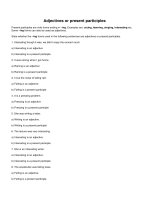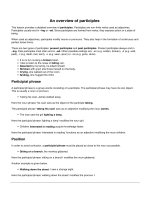Dangling participles
Bạn đang xem bản rút gọn của tài liệu. Xem và tải ngay bản đầy đủ của tài liệu tại đây (9.69 KB, 1 trang )
Dangling participles
Adjectives and verbs ending in –ing are called present participles. They must be used carefully.
Consider the following sentences:
Standing at the gate
, a scorpion stung the man.
This sentence seems to suggest that it was the scorpion which stood at the gate. Actually, it was the man. He was
stung by the scorpion when he was standing at the gate.
Now another example is given below.
Flitting from flower to flower
, the girl watched the bee.
The girl didn’t flit from flower to flower. The bee did.
The problem with these sentences is the incorrect use of the
participle.
A participle is a kind of verb form used to modify nouns. It serves the same purpose as adjectives. Participles are
also used to make continuous and perfect tense forms but that is not what we are discussing here. When a
participle is used as an adjective, the readers should be able to find out which noun the participle refers to. This
noun is called the antecedent of the participle. If the antecedent isn’t clear, the action will be attributed to the
wrong person.
These participles that are left dangling without a clear antecedent are called
dangling participles.
The example sentences given above need to be rewritten as:
A scorpion stung the man
standing at the gate
. (OR A scorpion stung the man who was standing at the
gate.)
The girl watched the bee
flitting from flower to flower.
Be first to know when grammar rules change! Sign up to our newsletter here: englishgrammar.org (It's free)
Powered by TCPDF (www.tcpdf.org)









